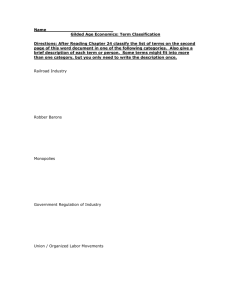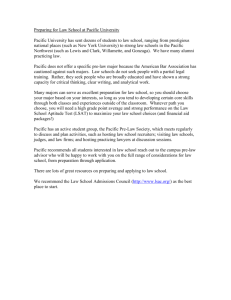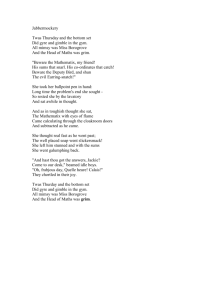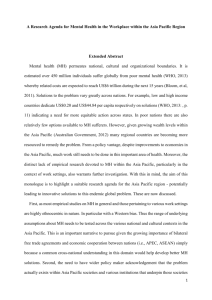************,***i*********** ******H*******K***********M***************N
advertisement
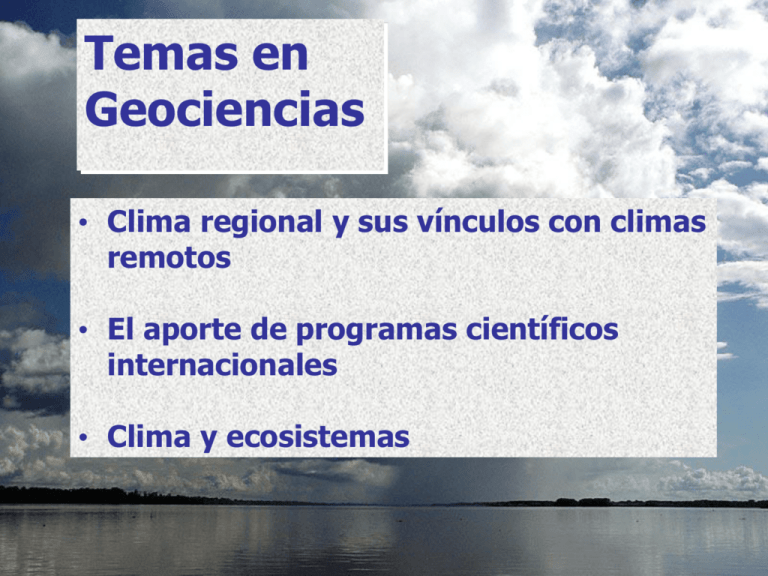
Temas en Geociencias • Clima regional y sus vínculos con climas remotos • El aporte de programas científicos internacionales • Clima y ecosistemas Elementos Claves del Clima de America del Sur SALLJ MONZON TORMENTAS CONVECTIVAS TORMENTAS SINOPTICAS I CIRCULATION ANOMALIES DURING W ET AND D RY P ERIODS IN SOUTHEASTERN SOUTH AMERICA DUR ING T HE AUSTRAL SUMMER (OCTOBER - MARCH) Periods with e nhanc ed convection over SESA weakened SA CZ H + T. anom H L - T. a nom warm- core ant icyclonic circulation ano maly ove r easte rn subt ropical South A merica. cold-core cyclonic circulation ano maly ove r southe rn South A merica intens ified Chaco low and abov e ave rage advect ion of warm and h umid air from the A mazon bas in intens ified subt ropical jet ove r easte rn S.A. Suppressed convection over SESA strong SA CZ L - T. a nom H L + T. anom Diaz & Aceituno, 2002 cold-core cyclonic circulation ano maly ove r easte rn subt ropical South America. warm- core ant icyclonic circulation ano maly ove r southe rn South A merica weak Chaco low and reduced advect ion of warm and hu mid air from the A mazon bas in weak subt ropical jet ove r easte rn S.A. Indian Ocean Events can affect the South American Climate Sep-Nov composite SST anomalies for 4 pure positive IOD events. Sep-Nov composite of 200 hPa eddy streamfunction anomalies for pure IOD events from reanalysis data Chen, Behera and Yamagata, GRL (2008) El episodio de humo del 15-20 Abril 2008 Hugo Berbery, Hector Ciappesoni y Eugenia Kalnay (GRL 2008) Visible Satellite Picture Model domain (WRF-ARW yellow box) 6 km grid spacing Simulation uses GFS analysis as BCs; Forecasts use GFS forecasts as BCs Low level wind convergence (blue) depicting the riverland Breeze during daytime The river helped to channel the lowlevel flow, and an in-land wind component increased the effect of the smoke near coastal areas. The duration of the event could have been predicted at least 5 days in advance due to the persistence of the flow Temas en Geociencias • Clima regional y sus vínculos con climas remotos • El aporte de programas científicos internacionales • Clima y ecosistemas VOCALS Targets QuickTime™ and a TIFF (LZW) decompressor are needed to see this picture. • Influences on and from remote climates • Better simulation by atmosphere-ocean GCMs • Unresolved issues in heat and nutrient budgets • Important links between clouds and aerosol QuickTime™ and a TIFF (LZW) decompressor are needed to see this picture. OCT -NOV 08 VOCALS REx: Ships Oct 2- Nov 3, 2008 80°W 13°S 79°W 78°W 77°W 76°W Cerro Azul 75°W 74°W 13°S Punta Cóndor VOCALS - PERU 2008 Tambo de Mora Pisco Peninsula Paracas Cruise Track 14°S 14°S Bahía Independencia Punta Infiernillos Punta Caballas 15°S 15°S San Nicolás San Juan Chala 16°S 16°S 17°S 17°S Nov 6- Nov 29, 2008 18°S 80°W 79°W 78°W 77°W VOCALS Peru Cruise track Cr. Olaya 2008/10 76°W 75°W 18°S 74°W BAe-146 C-130 Multi-platform sampling along the 20°S cross section will deliver: 1. A synthesised data set for testing of climate model representations of the SEP boundary layer. 2. A series of important case studies Do-228 Institutions Collaborating in VOCALS University Arizona State Concepción, Ch CSU Drexel U. Hawaii Manchester UK Miami North Carolina State Oregon State Reading U. Arizona U. Chile UCLA U. Colorado UCSD U. Leeds UK U. Washington U. Wyoming Research Labs Brookhaven Nat. COLA CNRS/LMD France IMARPE IPRC LEGOS NASA GSFC NCAR NOAA/CIRES NOAA/GFDL NRL Pacific Northwest Woods Hole Operational Centers BMRC Australia CPTEC Brazil ECMWF Int. JMA Japan NCEP US UKMO UK Funding $25M+ Logistic Support: UCAR JOSS Temas en Geociencias • Clima regional y sus vínculos con climas remotos • El aporte de programas científicos internacionales • Clima y ecosistemas Climate and Marine Ecosystems Regional Climate And Large Scale Drivers: Temperature Atmospheric and oceanic circulation clouds, precipitation hydrology, sea ice, rivers, chemical transport. pH Light Oxygen Extreme Events Nutrients Productivity Marine Ecosystems Contaminant Loading Acidification Coastal Monitoring + Assessment Hypoxia Coral Reefs Fisheries Harmful Algal Blooms Ecological Forecasting Society Marine Protected Areas Anomalies of (A) global air temperature, with the long-term increase removed (8); (B) the Pacific decadal oscillation (PDO) index (°C), derived from principal component analysis of North Pacific SST (10); (C) the atmospheric circulation index (ACI), which describes the relative dominance of zonal or meridional atmospheric transport in the Atlantic-Eurasian region (9); (D) atmospheric CO2 measured at Mauna Loa (parts per million) with the long-term anthropogenic increase removed (7); (E) the regime indicator series (RIS) that integrates global sardine and anchovy fluctuations (5); and (F) a southeastern tropical Pacific ecosystem index based (19) on (G) seabird abundance and anchoveta and sardine landings from Peru. All series have been smoothed with a 3-year running mean. Reference: Chavez et al. 2003: Anchovies to Sardines and Back: Multidecadal Change in the Pacific Ocean, Science 299 (5604), 217. Hypothetical oscillation with a period of 50 years: Anchovy regime. California Fisheries: Ocean Models with resolutions on the order of a few kms are needed Chlorophyll A From ROMS QuickTime™ and a TIFF (LZW) decompressor are needed to see this picture. Units: mg m-3 Temas en Geociencias • Finalmente, hay grandes incertidumbres sobre los impactos del cambio climático global sobre regiones específicas Intergovernmental Panel on Climate Change “…warming of the climate system is unequivocal.” IPCC models: DJF Precip IPCC AR4 models: Scenario 20C3M ; 1949-2003 El área de GEOCIENCIAS debe ser bienvenida al PEDECIBA Leading Mode of Variability In the Warm Season The aircraft CIRPAS Twin Otter DoE ASP G-1 NSF C-130 Chemistry and aerosol, cloud microphysics, turbulence Cloud optical properties (imaging spectrometer) Precipitation rate, cloud top and base height, cloud liquid water path, water vapor column, SST Drizzle, cloud properties cloud optical depth and liquid water path, aerosol optical properties, aerosol optical properties, SST NERC Dornier 228 UK FAAM BAe-146 Physical changes are in blue, and biological and chemical changes are in red. Climate Modeling AGCM OGCM QuickTime™ and a TIFF (LZW) decompressor are needed to see this picture. RAMS ROMS Physical Model Hierarchy, from very high resolution coastal, to coupled mesoscale, up to global coupled GCMs Low level wind convergence (blue) depicting the river-land Breeze during daytime Summary: Simulations were performed with the WRF model with a grid spacing of 6 km: (a) A five-day simulation forced by GFS analyses as boundary conditions; (b) As (a) but with realistic, high resolution water temperatures; (c) Five-day forecasts with initial and boundary conditions from the GFS April 12, 15, and 18 forecasts The boundary layer over the river remained low most of the time during the week of the fires The river helped to channel the low-level flow, and an in-land wind component increased the effect of the smoke near coastal areas. A simulation with more realistic water surface temperatures appears to indicate an even lower boundary layer over parts of the river The duration of the event could have been predicted at least 5 days in advance due to the persistence of the flow Figure 2. Hypothetical oscillation of a regime index with a period of 50 years. From the early 1950s to about 1975, the Pacific was cooler than average, and anchovies dominated. From about 1975 to the late 1990s, the Pacific was warmer, and sardines dominated. The spatial patterns of SST and atmospheric circulation anomalies are shown for each regime (10). The spatial pattern shows that warming and cooling are not uniform and that the eastern Pacific is out of phase with the central North and South Pacific. Some indices suggest that the shifts are rapid (dashed), whereas others suggest a more gradual shift (solid). Regime shifts are commonly associated with a change in index sign, but populations may also exhibit changes in abundance when the index stops increasing or decreasing. The first empirical orthogonal function (EOF) of global TOPEX sea surface height (SSH) is shown above the cool, anchovy regime. It accounts for 31% of the variance in 18-month low-pass filtered SSH from 1993 through 2001. Low SSH implies a shallow thermocline and nutricline when the coefficient (blue line) is positive. The coefficient is shown in blue together with surface chlorophyll anomalies (mg m-3) for the eastern margin of the California Current system from 1989 to 2001 (45), also low-pass filtered. The high chlorophyll after 1997-98 is consistent with the shallow thermocline of the eastern Pacific. Changes in the circulation of the subtropical gyre and its boundary currents are also indicated by the first EOF. This basin-scale anticyclonic (clockwise spinning in the northern hemisphere) gyre maintains a positive gradient in SSH from its center to its periphery. The changes described by the first EOF after 1997-98 can be interpreted as (i) stronger positive gradients in SSH between the gyre center and its eastern and southern boundaries that would be associated with stronger anticyclonic flow (stronger southward flow along the eastern gyre boundary and stronger westward flow along the southern gyre boundary) and (ii) weaker positive gradients in SSH between the gyre center and its western and northern boundaries that would be associated with weaker anticyclonic flow (weaker northward flow along the western gyre boundary and weaker eastward flow along the northern gyre boundary). Thus, after the recent shift evident after 1997-98, a stronger California Current and a weaker Kuroshio Current are indicated. Figure 3. Synthesis of Pacific conditions during the (A) sardine and (B) anchovy regimes. Physical changes are in blue, and biological and chemical changes are in red. California Fisheries QuickTime™ and a TIFF (LZW ) decompressor are needed to see this picture. Models with increasing resolution and decreasing domain size are “nested” to allow for computation. Sea Surface Temperature (SST) QuickTime™ and a TIFF (LZW) decompressor are needed to see this picture. Units oC September-November composite of rainfall and 850-hPa wind anomalies during pure positive IOD events for (a) observation and (b) SINTEX-F1 results. Shown values exceed the 95% level of confidence from a t-test. (c) Indices of central Brazil rain (bar), IOD (blue) and Niño (red).

